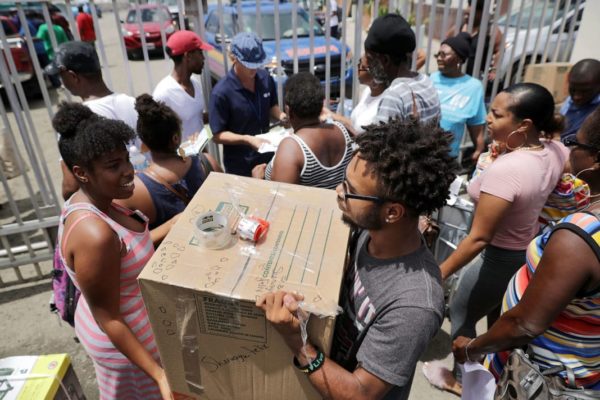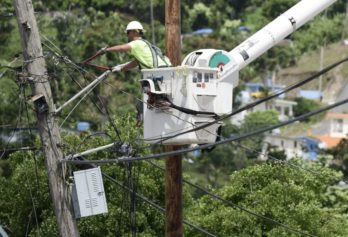
CRUZ BAY, ST. JOHN – SEPTEMBER 14: William de Leon sorts through the remnants of an office on Estate Lindholm, a hotel damaged by Hurricane Irma, in the Cruz Bay section of St. John in the US Virgin Islands on Sep. 14, 2017. (Photo by Jessica Rinaldi/The Boston Globe via Getty Images)
Scarce food, no electricity and communal dinners prepared over a bonfire. Trash and debris clutter the streets, water is limited and cell phone service is spotty at best. This is now the new normal for many Puerto Ricans and U.S. Virgin Islanders in the wake of Hurricane Maria, which pummeled the islands in late September. Packing sustained winds of more than 155 miles per hour, the Category 4 storm left communities completely flooded and caused “tornado-like” damage, downing power lines and ripping the bark off trees.
The death toll in Puerto Rico is now at 51 after officials said two more people died from a bacterial disease spread through animal urine. But the collapse of the island does not end there. Nearly 79 percent of Puerto Rico remains without power while 30 percent of people don’t have access to clean water.
Meanwhile, Hurricane Maria claimed the lives of nine people in the U.S. Virgin Islands and other Caribbean nations, including Dominica and the French territory of Guadeloupe.
“The country is in a daze — no electricity, no running water, as a result of uprooted pipes in most communities, and definitely no land-line or cellphone services on island, and that will be for quite awhile,” Hartley Henry, principal adviser to Dominican Prime Minister Roosevelt Skerrit, wrote in an email to the Miami Herald. Henry said Skerrit had to be rescued himself after the roof blew off of his home.
It’s been nearly six weeks since the devastating storms, and several Caribbean islands are still in recovery mode from Irma, Maria or both. In Puerto Rico, locals have been forced to get creative with their survival skills. Kevin Jose Sanchez Gonzalez told The New York Times he has been living in darkness since Sept. 5, the day before Irma made landfall and began chipping away at the island’s power system. “It’s like going back in time,” he said.
Other Puerto Ricans are still managing to make do with what they have, cramming four or five families into a single home, surviving off of canned food items and hand-washing dirty laundry in a bucket, the newspaper reported.
Meanwhile in the Virgin Islands, locals are struggling to get their hands on tarp to replace missing roofs lost to the storm. Island native and Red Cross volunteer Genevieve Whitaker said thousands of homes across St. Croix suffered extensive damage. For her, she said the main concern has been mitigating the number of people left without roofs.
“It has been pretty slow,” she told Atlanta Black Star. “We are now a month [into recovery] following the storm. While FEMA, along with the Army Corp. of Engineers, has initiated the [Blue Roof] program, which [provides] a sturdier type of roofing, the delivery of tarps was really, really abysmal.”
Whitaker has seen the struggle of locals first hand, as she started volunteering at a clinic shortly after Maria hit. She said disaster relief organizations like the American Red Cross, FEMA, and the V.I. Territory Emergency Management Agency have had a presence on the island, but it is not enough. Residents are still in need of supplies like generators, car power inverters and rechargeable batteries.

CHRISTIANSTED, ST CROIX, US VIRGIN ISLANDS – SEPTEMBER 17: Passengers carry supplies onto a ferry taking them to St. Thomas more than a week week after Hurricane Irma made landfall September 17, 2017 in Christiansted, St Croix, U.S. Virgin Islands. (Photo by Chip Somodevilla/Getty Images,)
Slow shipping and delivery of care packages carrying essential items has also been an issue for locals in the disaster zone. Whitaker says she has yet to hear from representatives from UPS, FedEx, DHL or the U.S. Postal Service about what’s going on in terms of shipping. She said officials have blamed the slow service on the internet and sorting issues — which she found hard to believe considering the island’s expensive fiber network connections.
“It’s pretty much up in the air,” she said. “There’s no information at all coming out about that. What I think the U.S. could really do – specifically Congress – is look into the whole matter of our international designation when it comes to shipping. I should have been able to go onto HomeDepot.com since my local Home Depot store wasn’t able to ship [what I needed] … and still have all the options I had before the disaster.”
“We need the light to be shined on us so that we can get what we need,” Whitaker added.Another area the Red Cross volunteer feels the U.S. should assist with the repair of the island’s schools, which were badly damaged by the hurricane. Whitaker said the damage has forced some schools to combine with others and that some are infested with mold created by the wet conditions.
Kari Loya, Head of School at Good Hope Country Day School in St. Croix thinks the conditions may force people to permanently relocate. “Every day that goes by without significant gain (power/connectivity/water/etc.), we lose more families,” Loya told ABS via email, adding that the governor has done a good job of delivering daily briefings and updates on recovery efforts. ” … Either more families leave the island or those who have already left begin establishing roots elsewhere. This makes our economic recovery even slower and longer.”
Still, he said government leaders could have been more effective at focusing clean up efforts on specific streets and having a larger police presence when curfews were lifted to ensure order and security.
While Puerto Rico has received far more media attention, the island nation is still struggling to get its hands on and distribute necessary resources. Barriers ranging from a lack of communication to blocked roads have prevented aid from getting to those who need it the most.

FAJARDO, PUERTO RICO – SEPTEMBER 12: Barefoot Davis, left, who lives on St. Thomas but has not been back to see the damage, helps the crew of East Island Excursions load boats with supplies headed for St. Thomas and St. John in Fajardo, Puerto Rico on Sep. 12, 2017. (Photo by Jessica Rinaldi/The Boston Globe via Getty Images)
Jose “Pache” Ayala, general manager for Puerto Rico at Crowley Maritime Corp. told USA TODAY that one port at San Juan terminal has been forced to store 3,400 containers of supplies, nearly double its usual limit. Moreover, he said the severe backlog has affected goods and supplies from FEMA, including bottled water, food, front-end loaders and about 75,000 gallons of gasoline.
More monetary help may be on the way, however. The U.S. Senate on Tuesday, Oct. 24, passed a $36.5 billion hurricane disaster relief bill that would provide $4.9 billion in low-interest Treasury loans to the U.S. Virgin Islands and PR, The Virgin Islands Consortium reported. President Donald Trump is expected to sign the bill into law.
In recent weeks, the real estate mogul-turned politician has been criticized for his response to the storms. Two weeks after Maria hit, he flew down to survey hurricane-ravaged Puerto Rico, and then met with U.S. Virgin Islands Governor Kenneth Mapp in a boat rather than in the island’s battered areas. Critics blasted Trump after he took to social media to grumble about the financial burden of aiding Puerto Rico and threatened to stop emergency funding.
Recovery mode is far from over for residents of Puerto Rico, the U.S. Virgin Islands and other Caribbean nations battered by Hurrricane Maria. However, locals like Whitaker are working to ensure the islands aren’t forgotten amid clean-up efforts after the storm. She for one is headed to the inaugural Obama Foundation Summit in Chicago on Oct. 31, in hopes of raising the profile of the Virgin Islands.
Going forward, she says she hopes the island learns and grows from this disaster. “I hope we build more resilient communities,” she said. “We as communities coming together to focus on much better planning as it pertains to neighborhood captains [and] examining house integrity … It’s a whole framework on how we should proceed.”


